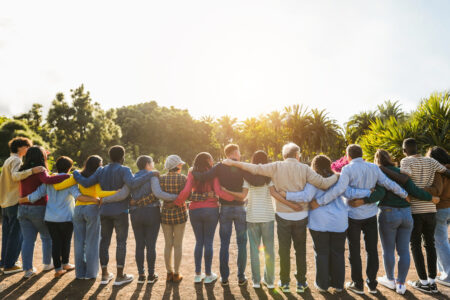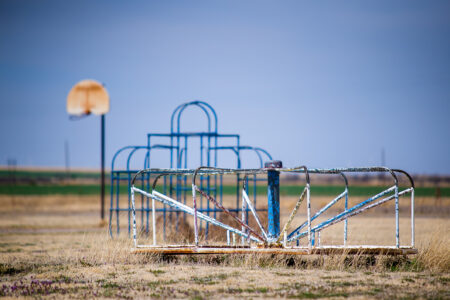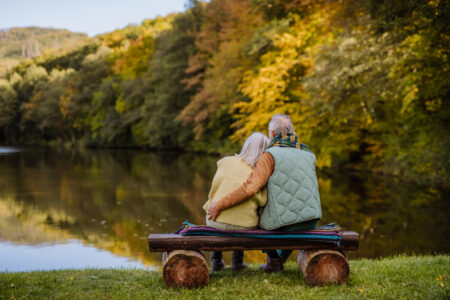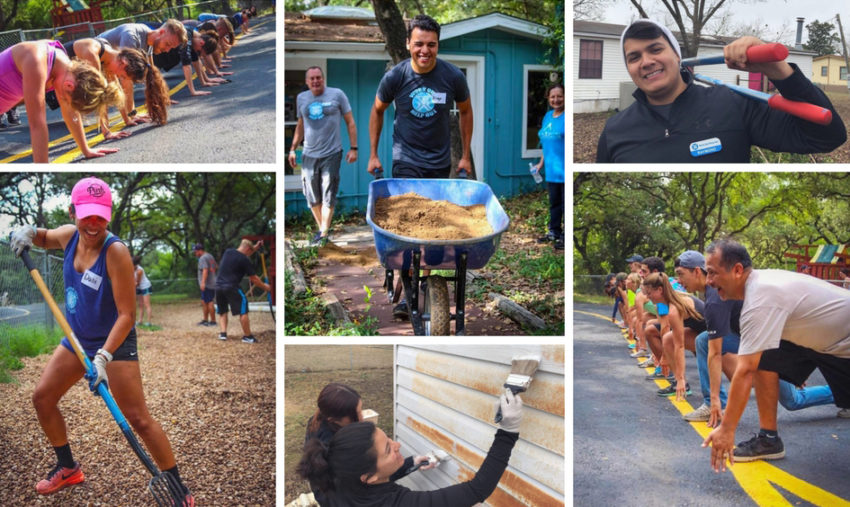
Share On Social!
Paul Rezaei loved being physically active as a kid, so much so that he became a personal trainer and has helped people get fit in San Antonio for 10 years.
One day, as Rezaei watched people spend energy to jog on treadmills and move weights, he had a revelation:
“Can’t we do this [work out] while doing something positive for the community?”
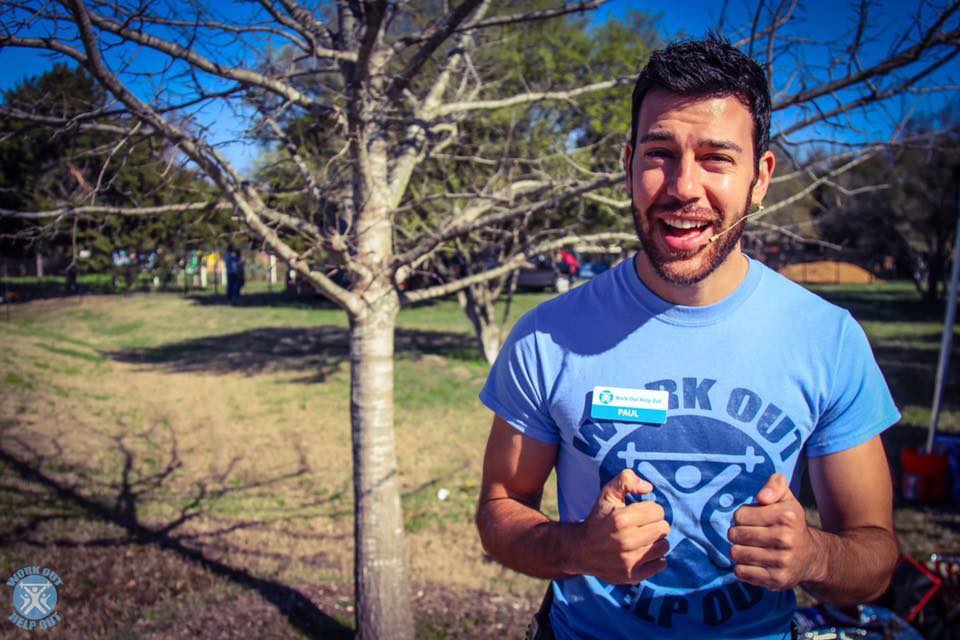
Rezaei wanted to host events where people could work out—and at the same time serve as volunteers to create gardens, help at-risk families, and improve the community.
How could he make it happen?
Physical Inactivity and the Need for Healthy Spaces
Rezaei, a trainer at Life Time Fitness, sees many people in San Antonio (67% Latino) struggle to get the recommended daily physical activity.
More than half of adults here are obese or overweight. 21% report no physical activity leisure time, according to a Salud America! Salud Report Card for Bexar County. Latino neighborhoods tend to lack safe space for physical activity. Physical inactivity puts people at risk for obesity, heart disease, and diabetes.
But inactivity isn’t the only problem.
There is also a shortage of local volunteers, said William Richardson, a physical therapist and friend of Rezaei.
Volunteer labor is essential to the nonprofit sector,” Richardson told the Rivard Report. “Motivated volunteers can accomplish incredible amounts of work free of charge in a fraction of the time it would take nonprofit employees.”
Rezaei and Richardson wanted to solve both problems at once.
Developing a ‘Work Out, Help Out’ Concept
Their idea became “Work Out, Help Out.”
They started to host volunteer community service events.
At each event, a personal trainer also would provide “breaks” for physical activity for volunteers.
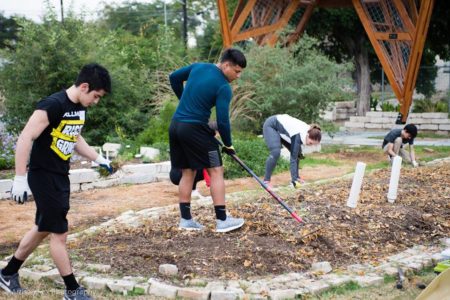
Rezaei and Richardson started out by setting up some events where friends could help pick up some trash at parks. They had about 10 volunteers per session. Rezaei and trainers provide exercise breaks of running, jumping, push-ups, and more.
“By incorporating unique elements into the framework of each volunteer event, [Work Out, Help Out] effectively benefits not only the community at large, but the individual volunteer as well,” Richardson told the Rivard Report.
Making ‘Work Out, Help Out’ an Official Nonprofit
Work Out, Help Out volunteer events started to grow in popularity. Rezaei’s workload increased.
He decided to make Work Out, Help Out an official nonprofit organization. That effort took about a year. The nonprofit leadership team includes Richardson, board chair; Rezaei, vice president (former president); Mark Williams, board secretary; Brian Friend, board treasurer; and Mark Hilborn, president/director.
Now, every Saturday, a Work Out, Help Out event draws about 45-50 volunteers.
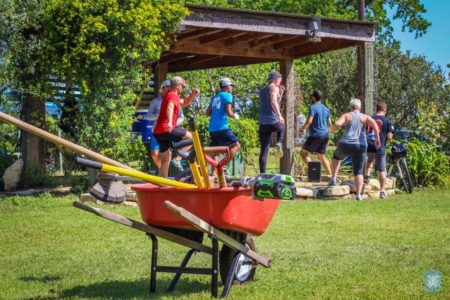
Richardson is responsible for getting volunteers out to sites and coordinating events each week, according to an alumni profile written by UTSA.
At events, volunteers enhance community gardens, paint and fix homes of the elderly, move gravel at schools, and more. Depending on the number of volunteers, they switch off between stations centered on volunteer work and exercise stations.
“Our goal at Work Out Help Out is to get people moving and to reduce unhealthy behaviors while improving the community,” Richardson said.
We want to help individuals not only with their physical well being but also with their mental emotional states.
 Paul Razaei
Paul Razaei
Vice-President, Work Out Help Out
We want to help individuals not only with their physical well being but also with their mental emotional states.
 Paul Razaei
Paul RazaeiVice-President, Work Out Help Out
A Volunteer Success
So far, Work Out, Help Out has provided more than 3611 volunteer hours, helped 20 individuals and organizations, and raised over $1,000 for other nonprofits, throughout the Alamo city.
“We’re trying to give people an incentive to come out here,” said Richardson. “We are trying to make it a little more apparent about the good that volunteering can do for you.”
Through the program and its volunteers, thousand of dollars in labor have been saved.
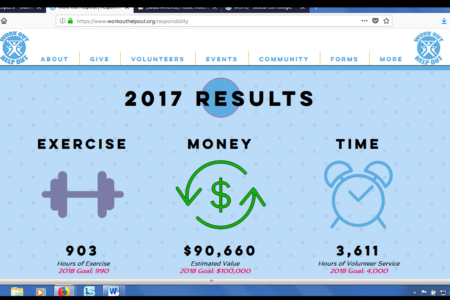
“About 98% of our volunteers come from Work Out Help Out….We rely on our volunteers to to help us conquer these really major inspiring tasks,” said Wendy Leonard, Nature Preserve Officer, on Fit City SA.com
WOHO volunteers have worked on projects for SETON Home, USO Lounge, Haven for Hope, and Blessed Sacred Academy, San Antonio Food Bank, and more.
“In two hours (volunteers) did a month’s worth of work while taking breaks to workout,” one volunteer told Richardson, he said.
Volunteers tell Rezaei and Richardson the program is beneficial, too.
“I can volunteer and I can also be active and I can feel like I am really you know getting my heart rate up and its exhilarating and I think that is the best part of this program,” said Ashley, a volunteer, in a YouTube video.
“Those who volunteer have lower mortality rates, greater functional ability, and lower rates of depression later in life than those who do not volunteer,” according to the program website.
Expanding the Model Beyond San Antonio
Rezaei and Richardson recently brought Work Out, Help Out to Houston.
They hope to start an Austin branch soon, according to KENS-TV news.
Are you ready to be part of a movement like this?
“This nonprofit model has engendered an infectious culture of excitement, altruism, and optimism that will propel the city of San Antonio forward into a new era of volunteerism,” Richardson told the Rivard Report.
By The Numbers
33
percent
of Latinos live within walking distance (<1 mile) of a park
This success story was produced by Salud America! with support from the Robert Wood Johnson Foundation.
The stories are intended for educational and informative purposes. References to specific policymakers, individuals, schools, policies, or companies have been included solely to advance these purposes and do not constitute an endorsement, sponsorship, or recommendation. Stories are based on and told by real community members and are the opinions and views of the individuals whose stories are told. Organization and activities described were not supported by Salud America! or the Robert Wood Johnson Foundation and do not necessarily represent the views of Salud America! or the Robert Wood Johnson Foundation.

